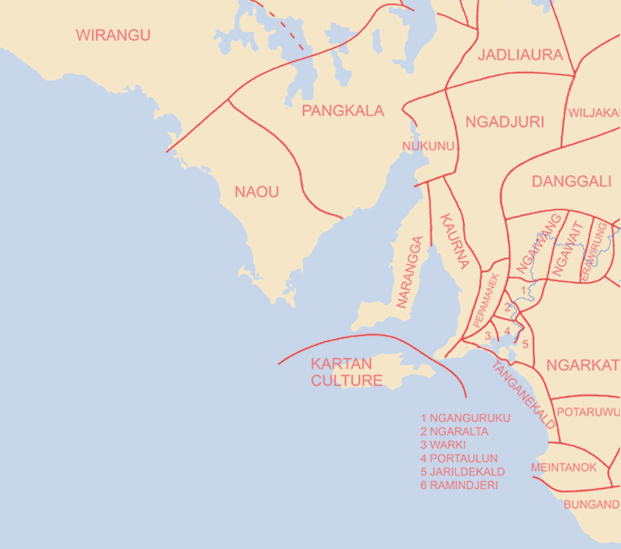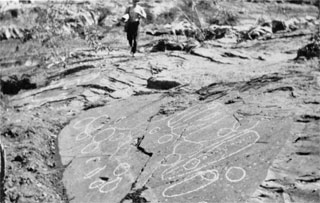

Aboriginal tribal areas. Extract from a map compiled by N B Tindale of the South Australian Museum.

A selection of aboriginal stone tools found in the Burra area. (Courtesy of the SA Museum.)
The traditional owners of the country around Burra are the Ngadjuri people. Their lands occupied an area from about Gawler to Orroroo, westwards to Clare and Crystal Brook and eastwards in the north to beyond Mannahill. In the early years of European settlement large gatherings of them numbering thousands were recorded at Clare and Orroroo. Gatherings at Burra seem to have been smaller, but are mentioned in the first thirty years or so of the mining and pastoral era c. 1840-70.
The Ngadjuri were a semi-nomadic people, but the importance of water supplies resulted in concentrations of them along streams throughout their territory. They ate a wide range of animals found in the district, though now many of them are locally extinct. This included the kangaroo, bilby, wombat, quoll, dunnart, bandicoot, emu and a range of other birds and lizards. Seeds and fruit were a substantial part of the diet and grinding stones found near Burra suggest the use of wattle seed flour.
Archaeological evidence places Aboriginal people in the area for at least 20,000 years and some indications would suggest for at least double that period. Scattered throughout their former territory there are campsites, economic sites, quarries, stone arrangements, scarred trees, burials and rock engravings. Tool fragments have been recovered from many places including Redbanks Reserve just to the east of Burra.
The Ngadjuri language has contributed many names to the modern landscape and in particular there are a number of place names ending in ‘owie’ meaning water and Kooringa, the original name for Burra.

The petroglyphs at Deep Creek, near Burra, which were discovered c. 1922 by J P H Biddle and F Spencer. This photograph was taken in 1925 when scientists from Adelaide visited the site.
Initial European contact occurred in 1839 when the explorer Edward John Eyre arrived. Governor Gawler and Captain Sturt also appeared. Sheep runs were established soon afterwards and some Ngadjuri became shepherds, shearers and roustabouts. Inevitably not all contact was benign and the loss of hunting ground led to conflict, including a reported massacre at Mt Bryan in 1844.
In the 1850s epidemics of scarlatina, measles and smallpox severely reduced the Ngadjuri population and survivors were concentrated at Pt Pearce, Quorn and Wilcannia. By 1878 they were said to be extinct around Burra, but the Ngadjuri survived and their descendants are proud of their ancestry and are making efforts to preserve their cultural heritage and language.
Ngadjuri in reports from Burra
There are surprisingly few references to Ngadjuri in the immediate vicinity of Burra in the nineteenth century press. Most reports are of events somewhat further north or refer to Aboriginal Australians who are clearly itinerant, with no evidence that they are Ngadjuri. There are a number of court cases in which local publicans are charged with supplying alcohol to Aboriginal people. In fact most references come from the later reminiscences of early pioneers.
SA Register
1 August 1849
Prize Boxing is rife in Kooringa, with sums of £1 to £5 a-side being staked. There are too few police to interfere in this brutalising amusement. After one such fight between 'Paddy the Horse' and 'Scotchy' some men of violence, miscalling themselves 'miners' got up a row with a few Aboriginals, one of whom received a blow that would have fractured a white man’s skull.
In 1852 the same source reported that during the gold rush to Victoria 'Kooringa Aborigines held a large conclave on Tuesday last to deliberate on measures necessary to be taken in consequence of the desertion of the country by the white men.' Although there were isolated attacks on shepherds, in June 1852 the Protector of Aborigines reported that ‘upwards of 200,000 sheep were in the charge of native shepherds.' He also said 'that in no instance has the confidence placed in them been taken advantage of.'
Two references from the 1860s point to dwindling numbers of Ngadjuri around Burra.
SA Advertiser
8 January 1861
On Saturday night about 40 of the natives held a corroboree near the Bon Accord Mines, a goodly number of Redruth and Aberdeen people being there to see the dance .
The comparative absence of Ngadjuri around Burra by 1870 is indicated by the following report.
SA Advertiser
3 February 1866
Several of our sable friends....to the number of about 60, and principally from Bungaree, Crystal Brook, Canowie and Mount Bryant, [sic] assembled together, about two miles north of the Burra, and held a corroboree. So scarce are the natives here now that the sight of such a number is considered quite a rarity.
More than a dozen Aboriginal Australian are buried in the Burra Cemetery, but there is no way of knowing how many are Ngadjuri people.
From time to time skeletons of Aboriginal Australians are found on properties in the district and in April 1900 the local paper carried an extensive report on one such discovery within the town.
Burra Record
11 Apr. 1900
Mr A. Fuss, was engaged excavating his back yard at Aberdeen on Thursday morning when he came across one or two bones. After a few drives of the pick and the application of the shovel additional bones were found, and Mr Fuss than came to the conclusion that someone had been buried there. Subsequently the skeleton of an aboriginal was unearthed. The body was intact but the bones from the hips down were disarranged, still the large bone of one of the legs was complete down to the foot. The right arm when the body was placed in the hole, which is about 18 inches below the surface, was put across the face and the fingers were bent under the palm of the hand. The front teeth were much decayed, but strange to say the molars on the jaw were remarkably well preserved, the ivory on the teeth being very plainly seen. Time has, apparently, with the aid of lime, transformed the bones into petrified stone. The skeleton measured about six feet, and it is said to be that of a male Aboriginal. Quite a number of persons inspected the skeleton which has been buried again. Mr W.J. Davey under instructions photographed the relic which can be inspected at the Record Studio. Local geologists consider he died at least 100 years ago because of the marks on the bones and their condition.
Ngadjuri in the reminiscences of pioneers.
Richard Reed (1837-1930) came to Burra in 1847. In the ‘Burra Record’ in 1917 he recalled that in the 1850s Ngadjuri were common in the town and corroborees were also a common sight. In the same year the paper reported that Mrs Simpson (1824-1918), who had been a pioneer on the Booborowie Run, recalled Ngadjuri being common there in the 1840s and ‘at first very wild, but later became more friendly.’
John Rosewall (1863-1944) said he could recall watching corroborees on the site of the Burra School. This would suggest large gatherings of Ngadjuri at Burra in the late 1860s and is possible in light of the 1866 report; even if rare.
Burra Record
18 Apr. 1934
Solomon Williams of Glenelg: Reminiscences of Burra in the 1850s.
Among the attractions of Whit-Monday Holiday was occasionally the roasting of a whole bullock, which I saw on two occasions. It took place on level ground just beyond the Burra Hotel. Complete with head and horns it was chained to a spit. The wood was laid and the flames melted the fat. It was never properly roasted in this crude way. Wind deflected the flames and the heat and after hours of treatment no proper use could be made of it. On one such occasion a number of Aborigines were present and took away great quantities of half-raw beef to their nearby camp.
As happened across South Australia, Ngadjuri were decimated by European introduced diseases both before and after settlement. The survivors were then displaced northwards and ultimately many ended up at Point Pearce Mission after 1868. Apart from burials the most tangible evidence of Aboriginal occupation of the area lies in the impressive petroglyphs at Deep Creek and stone tools and fragments from various sites.